Advent 2024 - Midwives
Kevin Ireland
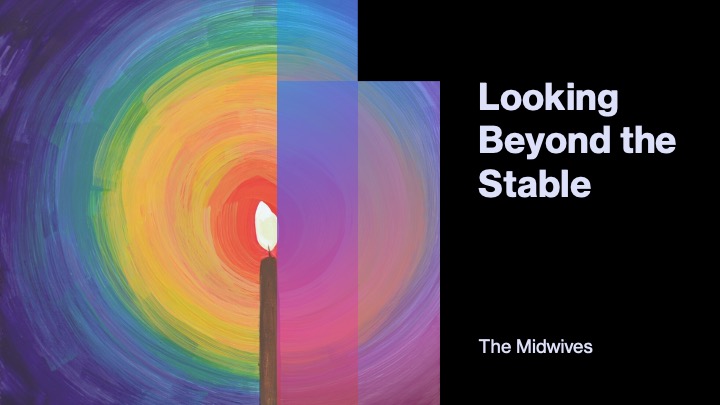
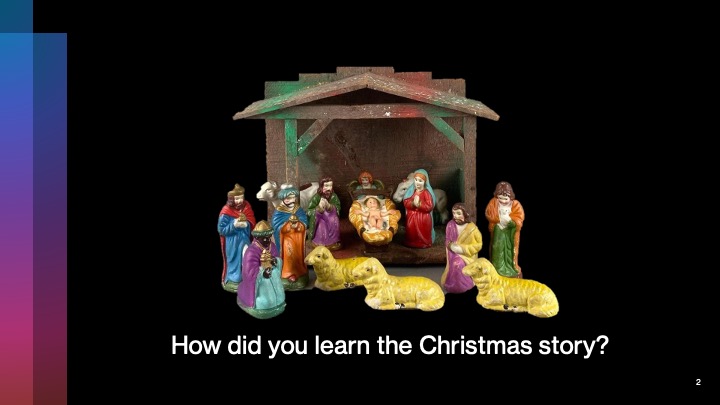
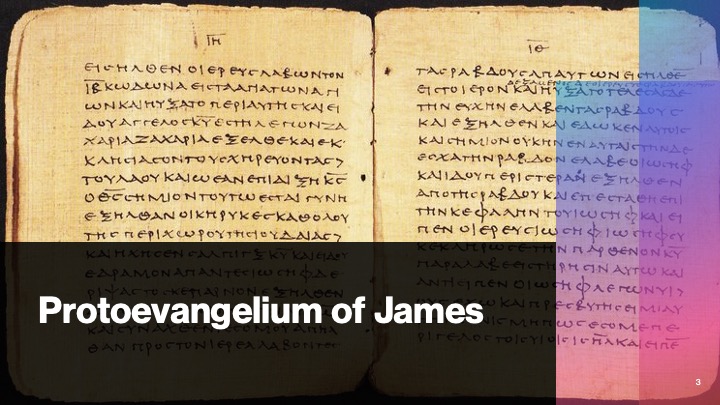
Gospel of James – 2nd century infancy gospel
The earliest surviving assertion of the perpetual virginity of Mary, meaning her virginity not just prior to the birth of Jesus, but during and afterwards,[4] Condemned by Pope Innocent I in 405,rejected by the Gelasian Decree around 500,
The Gelasian Decree (Latin: Decretum Gelasianum) is a Latin text traditionally thought to be a decretal of the prolific Pope Gelasius I (492-496). The work consists of five chapters: the second chapter of which is a list of books of Scripture defined as part of the biblical canon by a Council of Rome, traditionally dated to Pope Damasus I (366–383) and thus known as the Damasine List.[1] The fifth chapter of the work includes a list of works not encouraged for church use .It became a widely influential source for Mariology.[5]
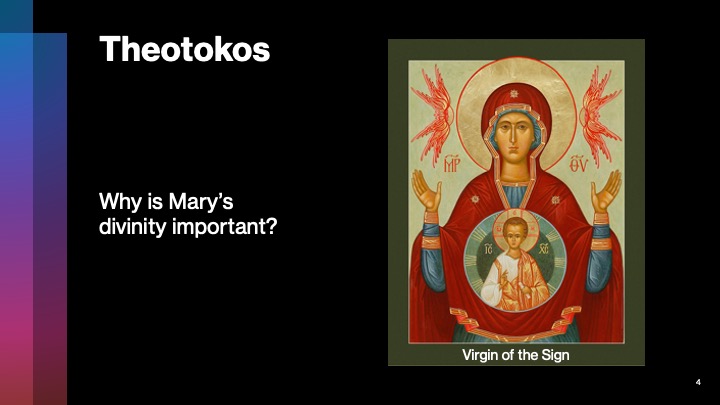
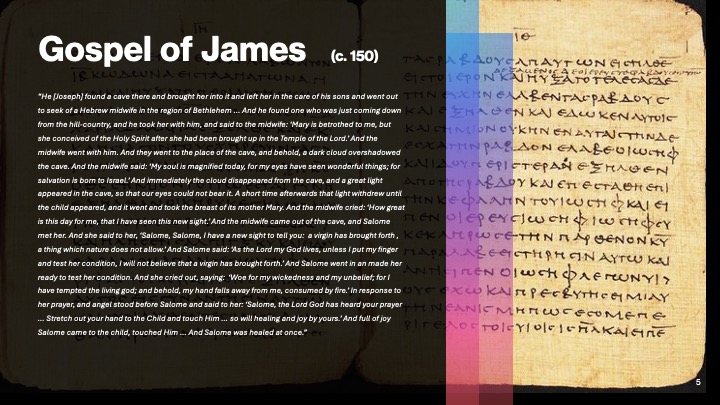
This is described in some detail in Chapter 18: Time Stands Still. Let's read some of the key points:
(1) And he found a cave there, brought her (to it), and stationed his sons with her and went to look for a Hebrew midwife in the region of Bethlehem.
(2) Now I, Joseph, was wandering but not wandering. And I looked up to the dome of heaven and saw it standing still, and into the sky, and I was astonished to see that even the birds of heaven were still. And I looked at the ground and saw a bowl lying there, and workers reclining, and their hands were in the bowl, and they were chewing but not chewing, and they were picking up food but not picking up food, and they were bringing it to their mouths but not bringing it to their mouths. Rather, all their faces were looking up.
And I saw sheep being driven, but the sheep stood still. And the shepherd lifted his hand to strike them, but his hand was raised. And I looked into the torrent of the river and saw young goats, and their mouths were in the water but not drinking.
And suddenly, everything resumed its course.
Chapter 19: Jesus’ Birth
(1) And look! A woman was coming down from the mountain, and she said to me, “Man, where are you going?”
And I said, “I’m seeking a Hebrew midwife.”
And in reply she said to me, “Are you from Israel?”
And I said to her, “Yes.”
Then she said, “And who’s the one giving birth in the cave?”
And I said, “My betrothed.”
And she said to me, “She’s not your wife?”
And I said to her, “Mary was nurtured in the Temple of the Lord, and it was decided by lot that she would be my wife, yet she’s not my wife; but she’s conceived from the Holy Spirit.”
And the midwife said, “Really?”
And Joseph said to her, “Come and see.”
And the midwife went with him. (2) And they stood in front of the cave, and a bright cloud overshadowed the cave. And the midwife said, “My soul is magnified today, because my eyes have seen something wonderful. Salvation has been born to Israel!”
And immediately the cloud withdrew from the cave, and a great light appeared in the cave, so that their eyes couldn’t bear it. And a little later, the light withdrew until an infant appeared. And he came and took the breast of his mother, Mary.
And the midwife cried out and said, “How great today is for me, that I’ve seen this new miracle!”
(3) And the midwife went out from the cave, and Salome met her.
And she said to her, “Salome, Salome, I have to describe a new sight to you. A virgin has given birth, which is against her nature!”
And Salome said, “As the Lord my God lives, unless I examine her condition, I won’t believe that the virgin has given birth.”
Chapter 20: Salome’s Examination
(1) And the midwife went in and said, “Mary, position yourself, because there’s no small test coming concerning you.”
And Salome examined her. And Salome cried out and said, “Woe because of my lawlessness and my unbelief! Because I’ve tested the living God, and look! My hand is on fire and falling away from me!”
(2) And she dropped to her knees before the Lord, saying, “God of my ancestors, remember me, that I’ve descended from Abraham, Isaac, and Jacob. Don’t make an example of me to the people of Israel, but give me the back to the poor, because you know, Lord, that in your name I’ve healed people, and I’ve received my wages from you.”
(3) And look! An angel of the Lord appeared, saying to her, “Salome, Salome, the Lord of All has heard your prayer. Bring your hand to the child and lift him up, and you’ll receive salvation and joy.”
(4) And Salome joyfully went to the child and lifted him up, saying, “I worship him, because a great king has been born to Israel.” And immediately Salome was healed, and she left the cave justified.
And look! A voice was saying, “Salome, Salome, don’t report the wonderful things you’ve seen until the child comes into Jerusalem.”
Theotokos – controversy about how a human woman could give birth to Christ/God (too icky – better to make Mary divine)
Salome - Similar to Thomas’ statement in John 20:24-19
Scene of burnt hand and healing rarely depicted – Why? (too intimate? too offensive)
Salome was an incredibly popular name among Jewish women in the first century CE. "Salome" is the Greek form of a Hebrew name that could be spelled like Shlomit or Shulamit. It's derived from the well-known Hebrew word shalom, meaning peace, just like the name Solomon. There were a number of notable Jewish women from this time period with the name Salome, including Salome Alexandra, a queen of Judea from the first century BCE; Salome I, the sister of Herod the Great; and Salome II, the daughter of Herod the Great.
Read More: https://www.grunge.com/1284671/fascinating-history-tomb-jesus-midwife/
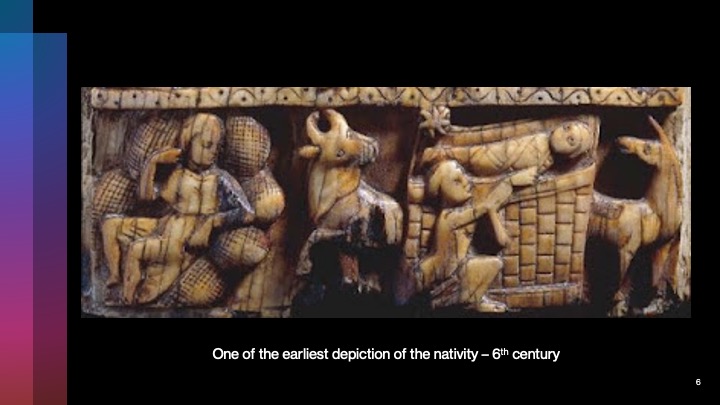
Part of an ivory panel in the British Museum, depicting a 6th century version of the Nativity (the 6th century marks the beginning of the medieval period.) Many representations of the Nativity on 4th and 5th century stone sarcophagi, which come from the regions under the influence of the Roman Empire.
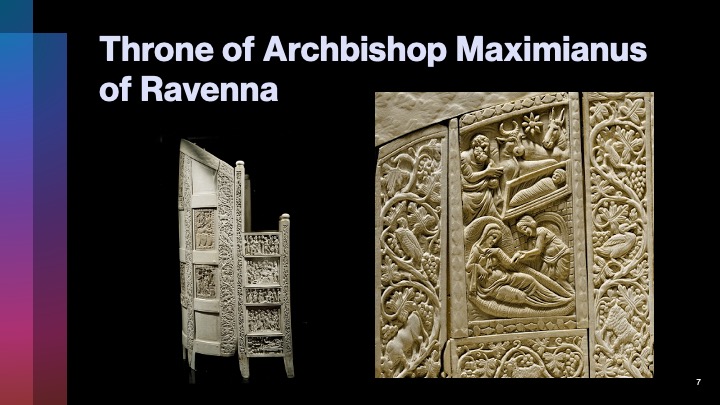
Throne of Archbishop Maximianus of Ravenna
The Throne of Maximian (or Maximianus) is a throne that was made for Archbishop Maximianus of Ravenna and is now on display at the Archiepiscopal Museum, Ravenna.
Born: 499 AD, Pula, Croatia. Died: February 22, 556 AD (age 57 years), Ravenna, Italy
Maximianus of Ravenna, or Maximian was bishop of Ravenna in Italy.
Ravenna was then the capital of the Byzantine Empire's territories in Italy, and Maximianus's role may have included secular political functions.
Carved in the Greek East of the Byzantine Empire and shipped to Ravenna, long been scholarly debate over whether it was made in Constantinople or Alexandria.
The style of the throne is a mixture of Early Christian art and that of the First Golden Age of Byzantine art. Carved ivory panels, with frames of winding vines and grapevines, on a wooden frame.[4]
The throne itself is large with a high semi-circular back and may have held a jeweled cross or Gospel book for some of the time.[5]
The ivory carvings are done in Relief (to rise) sculpture made from marble. Figures appear to be rising from the stone.
Panels depict important biblical figures.The back of the throne shows scenes of the Life of Christ, the sides include scenes of the Story of Joseph from the Book of Genesis, the front of the throne are the Four evangelists around John the Baptist, who is holding a medallion with the Lamb of God and Maximian’s name above him.
In the nativity scene Salome is extending her crippled arm to Mary.
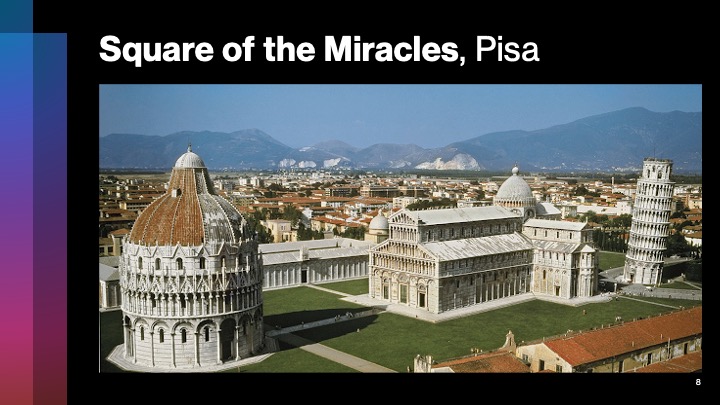
Square of the Miracles, Pisa
Pisa is recognized for its outstanding medieval art, and the Piazza dei Miracoli (or Square of Miracles) is one of the most exceptional architectural complexes in the world.
The complex consists of the Pisa Cathedral, the Pisa Baptistry, the Campanile (the bell tower commonly referred to as the Leaning Tower of Pisa), and the Camposanto Monumentale (or Monumental Cemetery).
Blending Romanesque and Gothic style
The grand Gothic cathedrals that were erected over hundreds of years were a source of civic pride, and often the primary source of work for artists. Work was begun on the Pisa cathedral in 1064 and on the Baptistry in 1153.
During the construction of the monumental edifices, which took over 100 years, the original architects would pass away and others would have to continue the work.
This change over often meant changes in the design to reflect current trends.
In the Pisa Baptistry the original style was Romanesque – you can see the typical curved arches on the lower stories.
As work continued, Nicola Pisano and his son Giovanni were brought in to serve as both architects and sculptors. Nicola was responsible for the upper stories and dome of the Baptistry. He adjusted the plans to the newer Gothic style, evident in the peaked arches and more intricate details.
The building embodies the transition between styles.
Example of the Eastern influence on Western RC
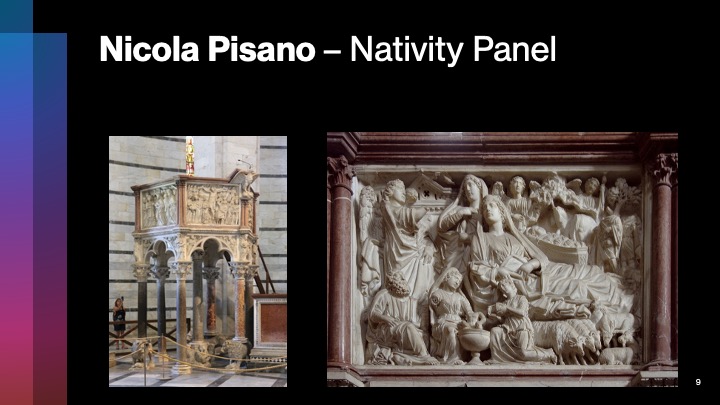
Nicola Pisano – Nativity Panel
Relief (to rise) sculpture made from marble. Figures appear to be rising from the stone.
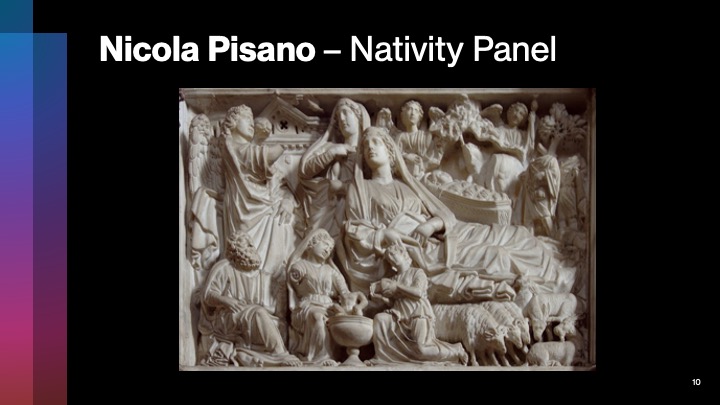
Nicola Pisano – Nativity Panel
Art tells the story - Begin reading from upper left and work down
• Mary – Theology in Releif – relining (is huge – if she stood up she wouldn’t fit in the frame)
• hieractic scale – most importance – size
• Mary is composed, regal, and somewhat unattached to Jesus for a woman who has just given birth. Her seeming detachment from Jesus is due to his being fully man and fully God. He is not an infant in the usual sense: He is her Lord. Again, the work is communicating far more than narrative details–it is giving us a glimpse into the theology of the incarnation.
• The reclining position in this work could be due to the custom of ‘lying in’ after a birth. All things to do with birth and death were considered to be sacred, and a number of rites prescribed how these events were handled. A lying in period secluded the mother and protected her from resuming work too soon after giving birth - After a month, there was a ‘churching’ ceremony to reintroduce her back to society and to give thanks for her protection during birth
• Joseph seated in the bottom left (much smaller – uninvolved)
• relegated to a benign caretaker by many
• often portrayed as elderly, hence not a threat to Mary’s virginity
• sleeping, so as not to witness the birth (not worthy? sinful?) in contrast to animals who are watching
• two midwives give Jesus a bath (baptism) – Salome’s withered hands
• Gabriel annunciation (upper left)
• adoration of shepherds (upper right)
• (notice the goat scratching - lower right)
Crib or Coffin/ - manager seems to resemble a coffin – allusions to death common in nativity art
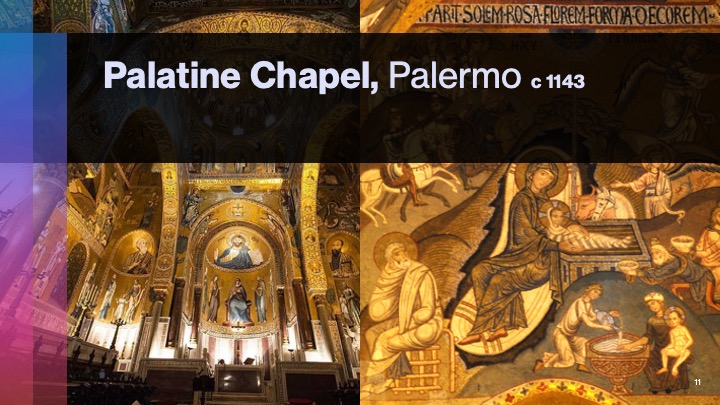
Palatine Chapel, Palermo c 1143
Palermo Sicily
Located on the first floor of the Norman Palace, now the seat of the Sicilian parliament institutional, the palace chapel was built by King Roger II in 1130, consecrated in 1140 as a private chapel of the royal family and compleatata in 1143.
That same year during his inauguration, at the time of the homily the arcivescono Taormina Philagathus by Cerami pronuciò:
“[…] The roof can hardly satisfy to watch it, and we wonder to see it and hear about it, being adorned with some fine carvings variously processed in the form of small baskets, and rifulgendo golden on all sides mimics the sky when the air serene shines for the choir of the stars […] “
Considered one of the greatest examples of historical and artistic coexistence between cultures and religions, involved Byzantine workers, Latin and Arab, who have managed to bring together the different styles in a harmonious and unique manner.
The Palatine Chapel is divided into three naves separated by columns of granite and marble supporting a structure of pointed arches. The dome erected over the three apses of the church together with the transept and apses same is entirely decorated with Byzantine mosaics.
The best known is the Christ Pantocratone that blesses all who visit the chapel. Unlike the dome, the ceiling of the nave and two aisles is made of wood and decorated with carvings and paintings of Arabic style called Maqarnas following the representation of paradise as it is described in the Koran.
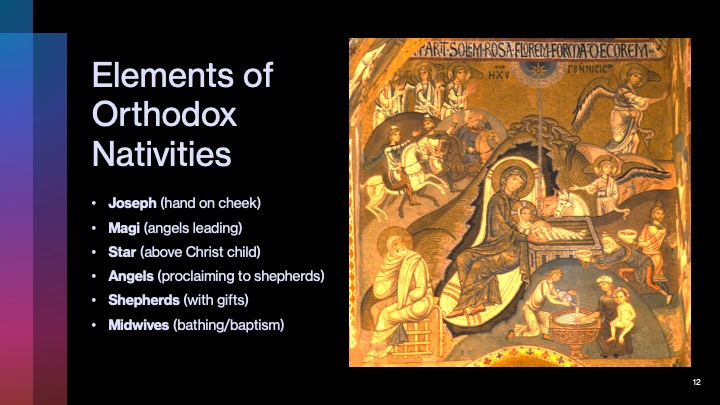
Elements of Orthodox Nativities
• Joseph (hand on cheek)
• Magi (angels leading)
• Star (above Christ child)
• Angels (proclaiming to shepherds)
• Shepherds (with gifts)
• Midwives (bathing/baptism)
The mosaic includes all the elements favored in Orthodox Nativities of the period. – tells the whole story in different scenes in the same picture panoptic to describe the method, meaning loosely “all” (pan) “seen” (optic), everything seen at once in the same image.
• In the center an angel shows us Mary as she moves the baby to the stable from the cave (next week)
• Clockwise from bottom left:
• St. Joseph with his hand to his cheek,
• the Magi and their angels,
• the star that guides them,
• the angel announcing to the shepherds,
• the shepherds with their gifts,
• the midwives bathing the child.
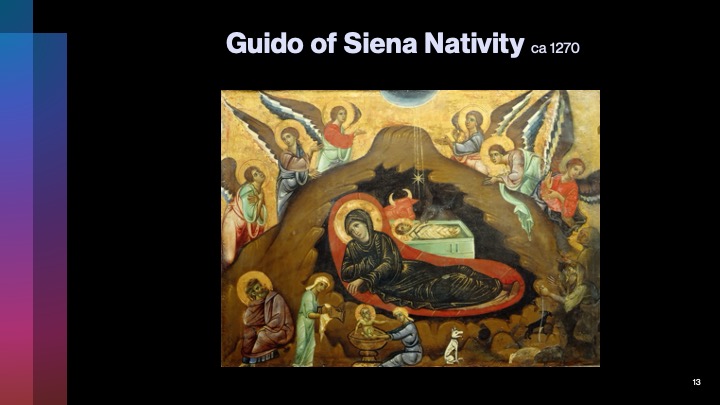
Guido of Siena Nativity circa 1270
Tempera on wood. Part of the Dossale di Badi Ardenga –
This painting belonged to a polyptych depicting twelve scenes from the life of Christ. The polyptych was dismembered at the beginning of the nineteenth century and the panels are now dispersed to various collections.
This one is owned by the Musée du Louvre
Unique elements of the dog and black goats – shepherds? Very old and skeleton like figures in lower right corner.
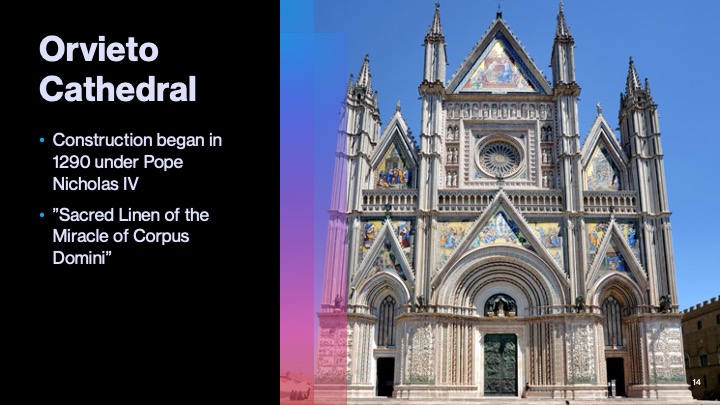
Orvieto Cathedral
• Construction began in 1290 under Pope Nicholas IV
• ”Sacred Linen of the Miracle of Corpus Domini”
• Orvieto Cathedral in Italy between Rome and Florence
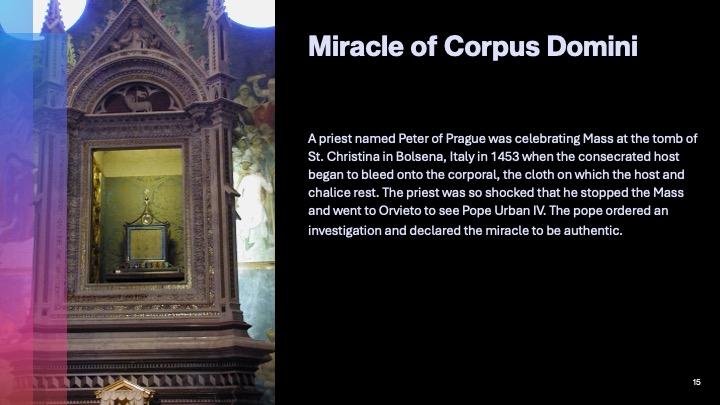
Miracle of Corpus Domini
A priest named Peter of Prague was celebrating Mass at the tomb of St. Christina in Bolsena, Italy in 1453 when the consecrated host began to bleed onto the corporal, the cloth on which the host and chalice rest. The priest was so shocked that he stopped the Mass and went to Orvieto to see Pope Urban IV. The pope ordered an investigation and declared the miracle to be authentic.
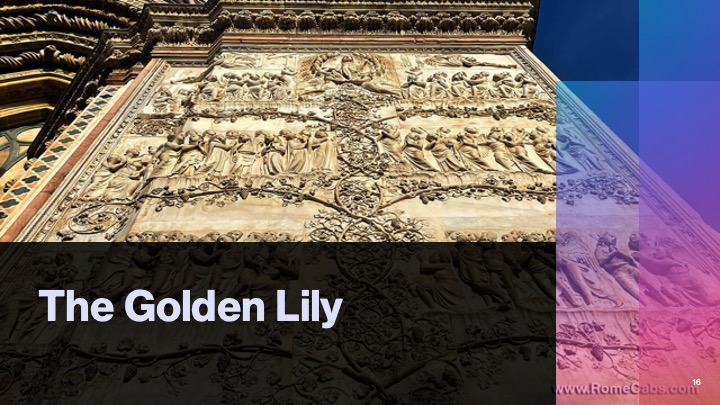
The Golden Lily
Known as the “Golden Lily” of cathedrals for its golden mosaics that illuminate the splendid façade.
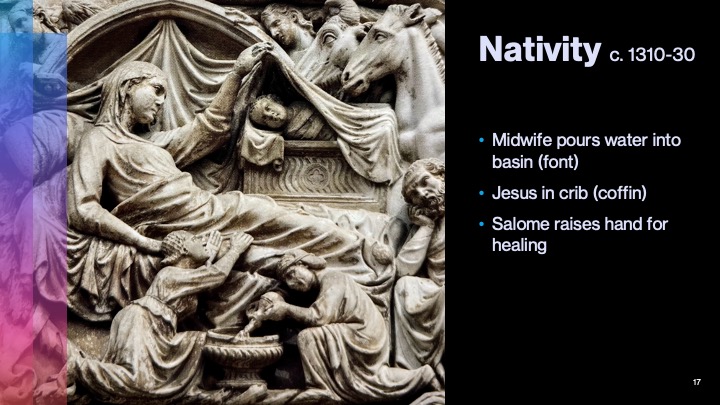
Nativity c. 1310-30
• Midwife pours water into basin (font)
• Jesus in crib (coffin)
• Salome raises hand for healing
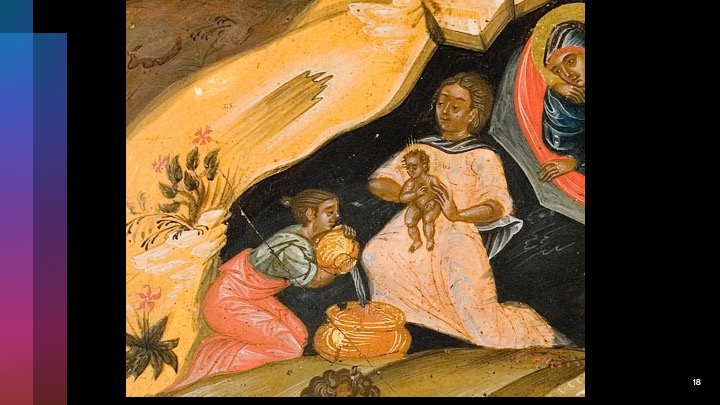
• Movement toward sacramental references – e.g. baptism (crib evokes eucharistic table?)
• in this icon, the painter has not given Jesus the usual “Orthodox” halo with the “Ho On” inscription, but has rather given him streams of light at his head, forming three points of the cross.
• And where in strict iconography, Mary is usually rather dismally turned away from the newborn child in the manger, here the scene of the washing is placed at left and close by Mary, so that she seems to be peacefully watching the washing of her child. It softens the dismalness of the old version.
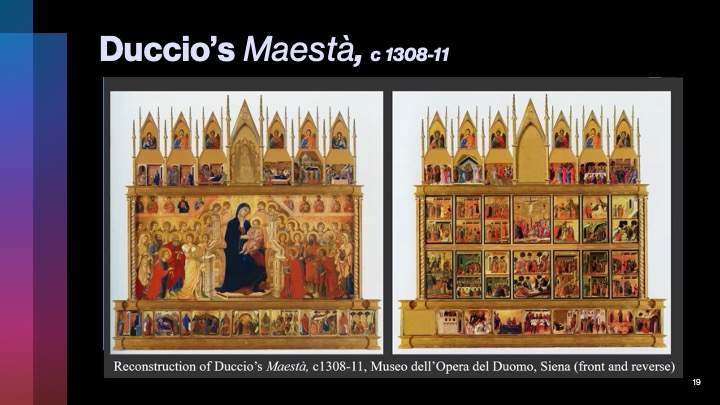
Duccio’s Maestà, c 1308-11
Alter piece from Seinna Cathedral (Italy)
When it was complete the predella featured seven narrative scenes on the life of Mary alternating with six portraits of prophets. The National Gallery's segment has Isaiah on the left and Ezekiel on the right.
When the whole piece was completed for Seinna cathedral (after 3 years) they paraded through the streets
1550 – styles changed and alter removed and put in a side – then sold off for money
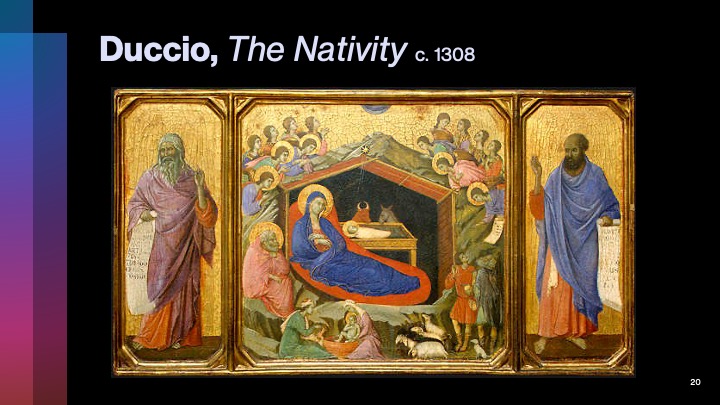
Duccio, The Nativity c. 1308 National Gallery of Art, Washington, DC
The Nativity, Duccio – three panels on the front lower right of the predella
Tempera on poplar 43x43.0 cm – took weeks to prepare the wood and had to be painted quickly
Vivid colors – Sienna style – tempera paint (pigments in egg-yoke) small scale 18” square. Have to paint quickly because paint dries fast. Surface preparation took weeks
Real gold leaf – expensive/conspicuous – surrounded by candles reflecting light/glowing
Description
• Depicts several scenes or stories – Christ’s birth and the manger as well as Christ bathed
• As traditional in both East and West, Mary wears a red robe under a blue mantle marked by a star (here just visible at her right shoulder).
• Midwives bathing Christ Child in what resembles a font – Christ lowered in like baptism
• Shepherd receiving word from angel and also worshiping Christ
• Structure is both a stable and a cave – blending east/west
• Church in Bethlehem has cave us Christ – grotto of Christ – also foreshadows death
• Star on front of stable with light radiating
• Angels faces look like Mary (artists used pattern for figures)
• Angels actively curious about what’s going on – heavenly hosts are also interested in what God’s doing
• Animals – most realistic depictions
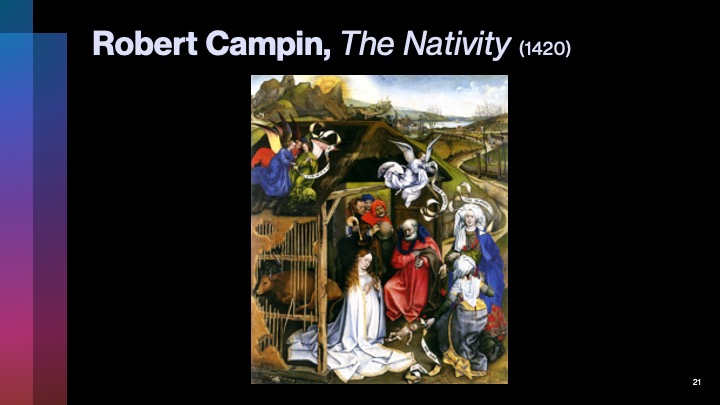
Robert Campin, The Nativity (1420)
Oil on wood, 87 cm x 70 cm Musée des Beaux-Arts, Dijon.
The midwives are clad in chic contemporary dress, in stark contrast to the poverty of the setting.
Salome extends her arm, above her an agnel hovers holding a banner that reads “Tangue puerum et sanabaris” (Touch the Child and you will be healed)
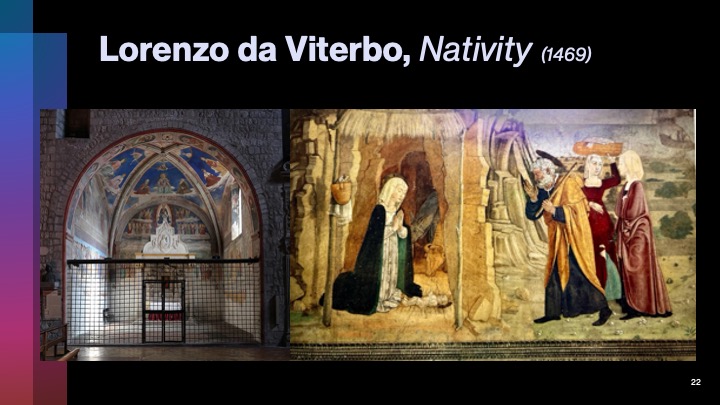
Lorenzo da Viterbo, Nativity (1469)
Fresco of the Nativity in the Mazzatosta Chapel in the church of Santa Maria della Verità Viterbo, 1469.
The depiction is unusual, showing Mary kneeling (left) by the newborn Christ Child, with the ox and ass perhaps warming His naked body,
On the right Joseph returning with two midwives.
The figure carrying a basket of linens required for midwifery on her head, seems to be in the act of explaining to her skeptical companion, Salome, the wonders ‘which nature does not allow’.
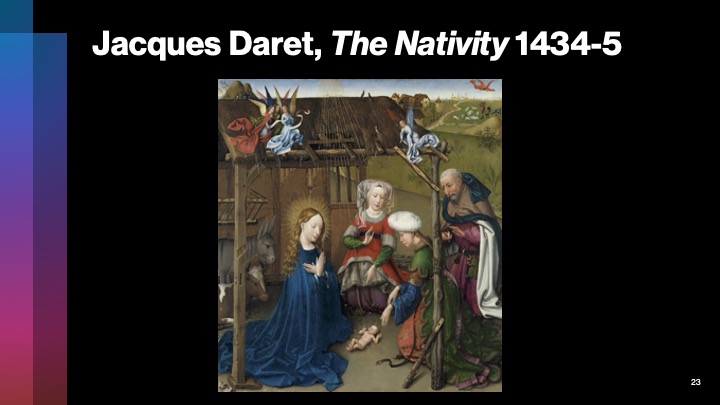
Jacques Daret, The Nativity 1434-5
In an altarpiece dedicated to the Virgin in the funerary chapel of Abbot Jean du Clercq in the Abbey of St Vaast in Arras. (N. France near Belgium)
Oil on panel - now at Museo Nacional Thyseen-Bornemisza, Madrid
Both midwives are shown in contemporary dress
Salome extends her hand close to the Infant, while an angel hovers over
Joseph hold candle to symbolize Christ as light of the world
Angle choir singing
Ox & Ass watching. Notice the angel telling the shepherds in the distance
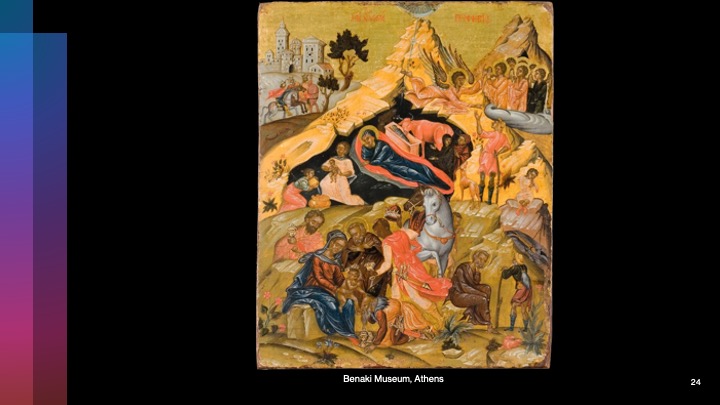
Icon from Crete
Great example of combination of Eastern/Western style – icon in Italian renaissance style
includes the usual elements common to Eastern Orthodox iconography but softened and “humanized” by the influence of Italian art
Title at the top – “The (of) Christ Holy Birth” – The Holy Birth of Christ
Mary lying on her “mattress” inside a stylized cave
Midwives de-emphasized with the animals by the manger –
Donkey is breying with emotion – Ox is placidly licking Jesus
Jesus doesn’t have halo – beams like a cross instead
Unlike earlier icons, Mary is not dismal or turned away from infant Jesus – peacefully watching the washing nearby (soften the older version)
Angelic annunciation to shepherds (upper right) – only one man (not surprised) and boy (playing horn) and old shepherd with Joseph
Flowers growing up through the rocks – even though traditionally winter
Question - What is he telling Joseph?
https://russianicons.wordpress.com/tag/protoevangelion-of-james/
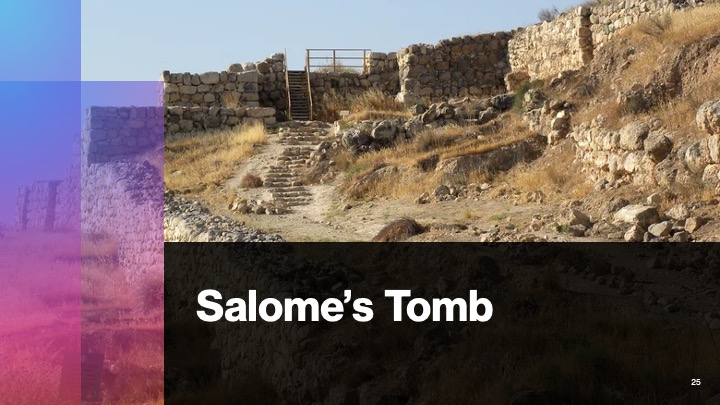
Salome’s Tomb
The actual, physical tomb that has been traditionally identified as that of Salome since the medieval period can be found in a cave near Tel Lachish National Park, about 30 miles southwest of Jerusalem.near the ancient city of Lachish, appears several times throughout the Hebrew Bible, including being besieged by the Israelite leader Joshua during his conquest of Canaan, as well as being besieged and conquered by the Assyrians, as recorded in the Book of Kings.
Kind of a rough legacy to leave behind, so you might understand why they might want to play up the midwife thing.
Read More: https://www.grunge.com/1284671/fascinating-history-tomb-jesus-midwife/
Part of a larger burial complex. Within the cave, there are various burial niches called kokhim carved out of the rock walls, as well as numerous ossuaries – essentially a receptacle or vault full of loose bones – in diverse states of disrepair.
It's likely that it was on one of these ossuaries that medieval Christians found the name Salome written and thus attached to the cave the identification with the burial place of Jesus' midwife.
Why Salome the midwife and not Salome the disciple or Salome, Jesus' aunt? Who knows. But whatever the reason, the site became a place of pilgrimage for Christians starting around the 5th century CE.
Archeological evidence suggests that the pilgrimage site was a fairly popular one well into the early Muslim period, continuing as a shrine until at least the 9th century.
Recent excavations have uncovered clay oil lamps that date to the 8th and 9th centuries which would have been used by pilgrims, either to light their way in the dark burial niches or else as part of their veneration of the shrine, similar to lighting candles at someone's grave.
Archaeologists have even uncovered a row of shop stalls surrounding the complex's forecourt where merchants would have rented or sold these lamps to pilgrims for this purpose. In the shop area, hundreds of lamps both whole and broken have been uncovered.
The idea that the veneration of Salome at her tomb continued into the Muslim era is supported by the fact that the interior walls of the cave are covered in inscriptions and engravings by visitors across the centuries. Some of these dozens of carvings are written in Greek and clearly from Christian pilgrims, but more than a few are written in Syriac or Arabic. But after the 9th century, there is very little known about what happened to the cave, though presumably, it fell into disuse as a shrine as tensions between Christians and Muslims during the Crusades would have made pilgrimages more difficult.
Read More: https://www.grunge.com/1284671/fascinating-history-tomb-jesus-midwife/
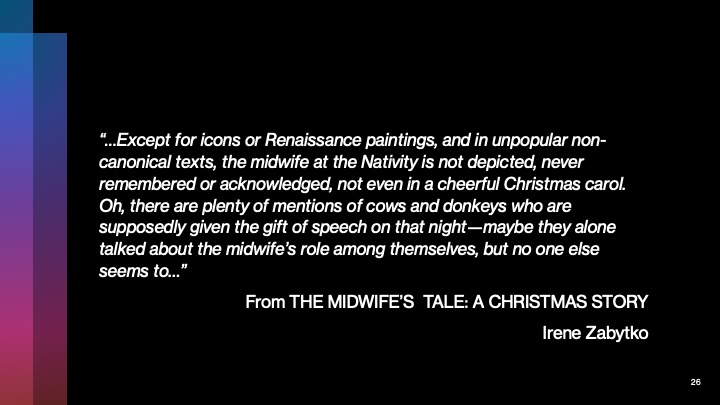
“…Except for icons or Renaissance paintings, and in unpopular non-canonical texts, the midwife at the Nativity is not depicted, never remembered or acknowledged, not even in a cheerful Christmas carol. Oh, there are plenty of mentions of cows and donkeys who are supposedly given the gift of speech on that night—maybe they alone talked about the midwife’s role among themselves, but no one else seems to…”
From THE MIDWIFE’S TALE: A CHRISTMAS STORY - Irene Zabytko
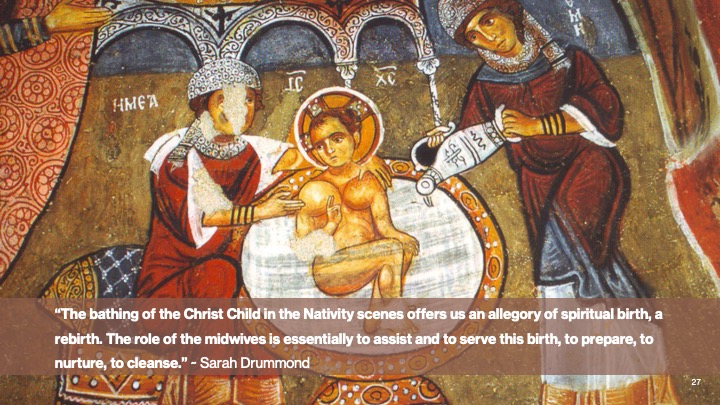
“The bathing of the Christ Child in the Nativity scenes offers us an allegory of spiritual birth, a rebirth. The role of the midwives is essentially to assist and to serve this birth, to prepare, to nurture, to cleanse.” ~ Sarah Drummond
Salome (right) and the midwife "Emea" (left), bathing the infant Jesus, is a common figure in Orthodox icons of the Nativity of Jesus; here in a 12th-century fresco from Cappadocia.
Elevation of Mary – related to elevation of midwives (human/female element) caring for Christ (not worshiping)
Witnessing the midwives ritually bathing the Christ Child at the Nativity we receive the impression of Christ’s dual nature – His humanity and his Divinity, the Incarnation, the Word made flesh.”
The bathing of the Christ Child in the Nativity scenes offers us an allegory of spiritual birth, a rebirth. The role of the midwives is essentially to assist and to serve this birth, to prepare, to nurture, to cleanse.
Midwives help bring Christ into the world. How are we called to bring Christ into our world?
^ The Midwives Video ^